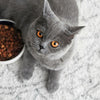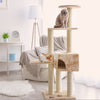How to Feed a Fussy Cat
- by Erika Buenaflor
Feeding a picky cat is a true challenge. Some cats are notoriously fussy eaters, and finding food that they will eat regularly is difficult. Some tips and tricks can help you make mealtime more enjoyable for your pet, and we discuss them in this article.
How to Make Your Picky Cat Eat
Before we move on to the tips below, it's important for you to make sure that your cat isn't suffering from an illness and that it's not the main reason for their lack of appetite.
Health problems that can cause a decreased interest in food in cats range from diabetes and kidney disease to hepatic lipidosis, pancreatitis, hyperthyroidism, and fever caused by an infection. Make sure to check with your vet, especially if your cat is a kitten, pregnant, or a senior, as these three categories are most vulnerable when it comes to diseases.
Decrease Treats or Switch Them Up
Like any other pet, cats love treats. But when they have too much, they can get bored of the same snack, not to mention that they add up to their daily caloric intake, so they might feel less inclined to eat their regular food.
If your pet is too picky, it might be time to cut back on the treats or try a different type, such as our Reel Fish Crunchers, packed in minerals, protein, and omega-3 fatty acids. You can also try giving your cat treats as a reward for when they eat their regular food.
Try a Different Recipe
Like humans, cats can get bored of their food, and if you've been feeding your pet the same thing for months, this is most likely the reason they're less tempted by the dry or wet food varieties you present them with. Try switching it up with a different flavour from the same brand or another one altogether. Just be sure to introduce the new food gradually to avoid upsetting your cat's stomach.
Switch Between Cat Food Types
Cats are picky when it comes to the texture of their food. Some cats like wet food, while others prefer dry. You can try alternating between wet and dry food or even try a mix of the two. Just make sure to read the labels and choose high-quality, nutritious food.
You can even consult a pet nutritionist or your vet, or choose a service that cooks homemade food for your pet, keeping in mind their unique dietary needs.
Positive Reinforcement When Your Cat Eats
Not all cats interact in the same way with their owners. Some are very dependent on their guardians' attention and care, while others prefer to spend time alone or watch humans from a distance. But almost all cats respond well to positive reinforcement, and not just in terms of training. Pets need to know that you are there for them, so whenever your cat eats their food, give them plenty of praise.
If your cat loves to play more than anything else, why not organise a quick playtime session whenever you see them eat a bit of their food? Or if your cat loves to feel pampered, you can use a Self Cleaning Slicker Brush and give them a nice massage after they have their meal. Relying on this strategy allows your cat to associate mealtime with positive experiences.
Try Different Feeding Locations
Some cats are picky about where they eat. If your cat is refusing to eat in their usual spot, try feeding them in a different location. You can also try using a different type of bowl or plate to see if that makes a difference. Some cats prefer shallow bowls, while others like deep bowls.
Additionally, because cats are such clean animals, they might not really appreciate having lunch or dinner right next to their litter box. Even if you use the most absorbent and odour-trapping product like our own Zero Odour Natural Litter, chances are that your pet is not going to want to eat right next to the spot where they 'go to the bathroom'.
What to Do if Your Cat Stops Eating
If your pet stops eating, it's important to address the issue immediately. A cat who goes without food for more than 24 hours can develop serious health problems.
If your cat has stopped eating, try offering them small amounts of food throughout the day. Try warming up their food or adding a small amount of water to make it more appealing. Some cats like the taste of warm bone broth, and while it might not be exactly nutritious, at least it is better than plain water. While cats can survive for several days without food, they cannot do the same without water, so it's important to keep an eye on your pet's behaviour in this sense.
If you are caring for a pet who is known to have a chronic condition, contact your vet as soon as you notice that they have lost their appetite.
Are Some Cat Breeds Fussier Than Others?
Some purebred cats such as the Siamese, Persians, and Orientals, are known to be fussier than their counterparts. But more often than not, it is a question of habit and how pet owners tailor their routines and behaviours to their own cats.
Final Thoughts
In addition to the tips above, you can do a few other things to make mealtime more enjoyable for your cat. Make sure their feeding bowls are clean and free of any leftover food. You can also try stopping free-choice feeding and gradually replacing old food with new food. Finally, consider making your own cat food at home using high-quality ingredients or a service for gourmet, healthy pet meals.
Feeding a picky pet can be a challenge, but with these tips, you'll be able to make mealtime more enjoyable for your cat. Remember to be patient and try different things until you find what works best.
- Posted in:
- australia
- behaviour
- cat
- cat explorer
- cat facts
- cat litter
- cats
- clean-up
- dog
- dog facts
- exercise
- food
- fun
- grooming
- health
- health-tips
- holiday
- how to help
- litter
- new arrivals
- new items
- news
- tips
- toys
- travel
- weekitty








